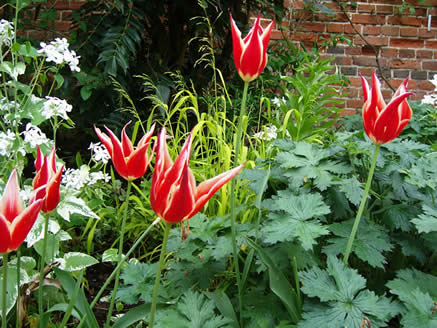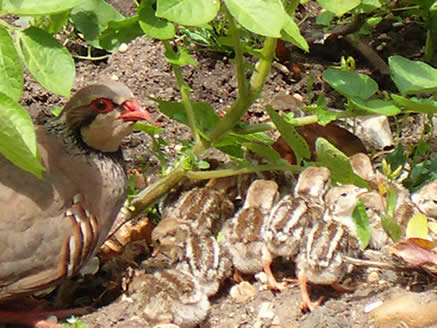Better in pots?
July 16, 2008
Did you know that gardening journalists get together in secret session to elect the plants we are going to grow? Nor did I, until I was invited to a Bulb of the Year lunch organized by the International Flower Bulb Centre. I'll give you three guesses where the IFBC lives. Clue: a flat little country across the North Sea. The twelve writers, or someone representing them, each nominated a spring- and a summer-flowering bulb and recited its merits. Cross examination followed. Why, Anna Pavord, do you put forward Ornithogalum ‘Nutans’? Rob Cassy of The Times advocated Triteleia ixioides ‘Starlight’. Both have modest wildflower charm, the polar opposite of Tulipa ‘Black Hero’, for example, championed by Kathryn Bradley Hole of Country Life.
I was not surprised to see the blue Camassia esculenta on the list: it seems to have found its own way into fashionable plantings already. I was surprised by how many of the most formal tulips, essentially cutting flowers, I would have thought, were put forward (as well as the lovely white selection of the species Tulipa clusiana called ‘Lady Jane’). I certainly couldn’t choose between two nerines, the white N. undulata chosen by Anna
Pavord or Stephanie Donaldson's choice of the more common sugar-pink
Quick, quick, grow
July 7, 2008
Yesterday we were praying for rain. Three weeks of dry, if not hot, weather had stopped the garden growing. In frustration we resorted to the only effective rain-dance: inviting friends to lunch in the garden. That worked, with unusual precision; a squall at one o'clock. It only measured 2.5 millimetres, a tenth of an inch, in the rain-gauge, but by tea time the new growth was measurable on almost every plant.
How do plants produce new shoots instantaneously? It is most remarkable, I always think, on oak trees. Pale, usually reddish or pinkish, 'lammas'-shoots break out all over the dark green crown. I measured one three hours after yesterday's shower; eight inches of pale shoot with 15 new leaves had appeared from nowhere - or rather from inside a tiny bud at the end of a twig. Was it already formed, packed in there in micro-miniature? How do cells spring into instant action, forming all the diversity of twig, leaf-stalk, leaf, and indeed new buds containing all these things again,
Fowl play
July 4, 2008
Visitors ignored the roses the other day, spurned the delphiniums, bypassed the hollyhocks and looked straight through the astroemerias. All they were interested in was the mother partridge parading her brood of fifteen chicks. Her nest was hidden just beside the greenhouse, filled with fifteen eggs perfectly broken in half, all at the same moment, it seems.
Somehow or other she manages to gather all fifteen under her body and wings for a nap, choosing an open spot with a clear field of view: the middle of the lawn or the potato patch. Why, though, do mother fowl take their chicks on route marches? The partridge is not as bad as a mallard who covers hundreds of yards in a day. No sooner is her family bobbing on one pond but she marshalls them all up and leads them the length of the garden to another, nippers falling by the way like grenadiers retreating from Moscow.
|

N. bowdenii. I thought the former for a pot, the latter for a border. But schizostylis, the truly flashy Gloriosa ‘Rothschildiana’, a strange dowdy red Calla lily, two dahlias, an eremurus, a gladiolus, galtonia and two eucomis all got an airing.
It was good to see relatively obscure bulbs battling it out with some obvious choices. The panel were given three formal criteria: Appearance, Versatility and Ease of Growing. I can hardly think of a bulb less versatile than a flaming parrot tulip, one with less striking appearance than Ornithogalum ‘nutans’, or many less easy to grow than Gloriosa ‘Rothschildiana’. The purpose of the conference, though, was simply to focus readers’ attention on bulbs at the time the catalogues come out. I tried to think of parallels with the other business I know: wine. The big difference is that bulbs don’t have vintages. Hence this scheme for an annual renewal of interest.
within minutes of water being available. What principle, and what urge, starts, plans and determines growth?
I can only imagine that roots in the ground when soil moisture is in short supply are like runners on the starting-block, primed to sprint. Rain dampens the surface, even as little as a few millimetres, and the signal goes out: get growing. The pent up sucking-power of billions of tiny root hairs, all intertwined in the soil, hoovers up the molecules of water, they shoot at incredible speed up the cambium corridor of every plant and cells start their programmed growth. How do they know how much to grow, or how many molecules their allowance will be? They are miraculously able to seize the opportunity, start and stop again as supplies are turned on and off. I went slowly round the garden last evening, smelling the dampness and the growth, finding evidence of movement in almost every plant I looked at.
Pines are an example of a plant that has no active buds until next spring, and no way of making adventitious ones - which is why rain doesn't make them grow, and when you cut one down it can't recover: a felled pine is a dead pine. Not a yew, though, or almost any other plant. The yew hedges are covered in spots of pale new growth. The border flowers are surging; the roses and every other shrub breaking out in tender growth. But strangest and most wonderful of all is that only rain can make this happen. You can water your plants as much as you like; they still only react like this to a shower.
So lots of garden parties.

Now the partridge family has disappeared, though we can hear cheeping from deep in the Mahonia nervosa. I expect they'll reappear tomorrow miles away - but not, I fear, anything like fifteen of them. |